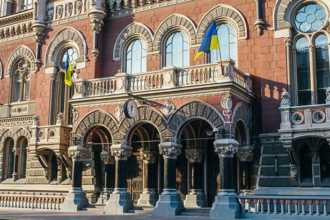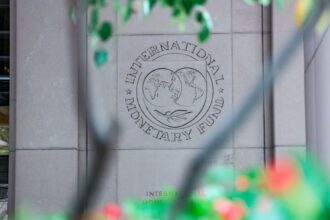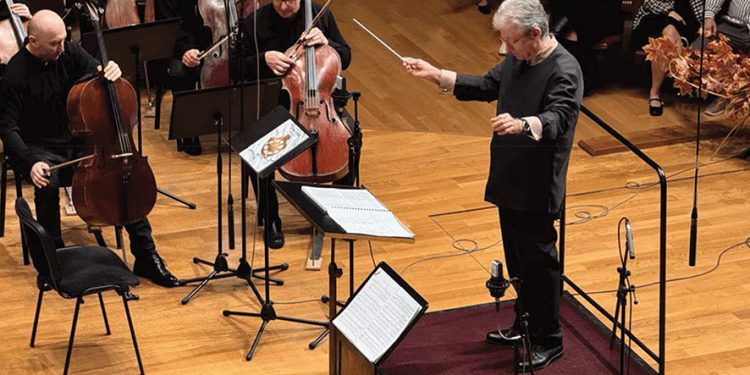The performance of Carmina burana on October 12 at the Djansug Kakhdze Tbilisi Center for Music & Culture, was more than a concert. It was a convergence of forces, with the Tbilisi Symphony Orchestra and the Georgian State Choir as well as the Choir of Batumi State Music Center all performing under the expert baton of renowned Hungarian Conductor Gabor Hollerung. This performance, which was part of the “Autumn Tbilisi” International Music Festival, featured Karl Orff’s masterpiece with a nuanced intensity that made for an evening of musical grandeur, emotional complexity, and nuanced intensity. The solo performances of Sophie Gordeladze Irakli Mojiri and Mikheil Aramishvili, as part of the ‘Autumn Tbilisi’ International Music Festival, added depth to this already monumental piece.
The Orff Phenomenon – A Ritual of Human Existence
Carmina Burana by Karl Orff is a classic in the choral-orchestral repertoire of the 20th century. It was first performed in 1937 and draws on medieval Latin texts to meditate on fate, fortune and the pleasures, and perils, of life. Orff arranged the work as a cantata scenic, combining a visceral rhythmic drive and lush harmonic textures. The repetition, pulsating beats, and declamatory vocals lend the work a sense ritualistic grandeur. The music’s raw power reflects the primal themes in the text.
Gabor Hollerung, The Architect of Momentum & Precision
Gabor Hollerung was the conductor for this performance. His reputation as a specialist of large-scale choral works and orchestral pieces has made him a highly sought-after conductor on the international music scene. Hollerung has a career spanning decades. His style is characterized by a distinct style that emphasizes rhythmic precision and structural clarity. He also has an unerring talent for sculpting vast musical landscapes. His experience as an orchestral conductor, and choral director, has infused his approach with a profound understanding of how to seamlessly integrate vocal and instrumental forces.
Hollerung is known for his ability to maintain a steady pace without losing nuance. Carmina Burana’s relentless rhythmic foundations require a conductor who can harness its energy and control the shifts in tone and mood. Hollerung’s technique was evident in this performance. He allowed the music’s organic development to take place, never rushing Orff’s powerful crescendos, and never letting energy wane during quieter sections. This balance created an ebb-and-flow dynamic that kept the audience on edge, while still allowing moments of lyrical elegance to shine through.
His gestures were expressive yet economical, giving the performers clear and unambiguous directions. Hollerung’s expertise in navigating complex textures is evident in his treatment for the choirs and orchestra. Under his baton, Carmina Burana’s rhythmic intricacies, from the opening, ominous strokes of “O Fortuna”, to the boisterous, energetic drinking songs, were executed with precision. His attention to details ensured that each section of the choirs and orchestra worked as a part of a greater whole, while still maintaining their individual sonic identity.
Hollerung’s understanding choral timbre enabled him to highlight the choirs textual articulation, without sacrificing orchestral colors. Hollerung’s crisp, driving pace allowed the text to ring clear and loud in sections such as “Veni veni venias,” which could easily become muddled by the rhythmic interplay of voices and instruments. Hollerung’s mastery of orchestral and choral integration was evident in his skillful balance between the vocal lines and the often thunderous orchestral backing.
The Georgian Choral Tradition – A deep well of power
The choral forces, which included the Georgian State Choir as well as the Choir of Batumi State Music Center, were another highlight of the evening. Georgia has a rich tradition of choral music, and the performance of the choirs reflected this. They combined technical brilliance and emotional depth. Hollerung tapped into this tradition by working with the choirs in order to produce a powerful, full-bodied sound that could also handle the dynamic demands placed on Orff’s score.
The choirs are responsible for much of the emotional impact in Carmina Burana. They embody the forces of nature and destiny that the text so powerfully evokes, whether they are invoking the capriciousness and whimsy of fortune in “O Fortuna” or enjoying the raucous joys of spring and the summer in “Veris leta facies”. Hollerung, the architect that he is, shaped the performance with precision to bring out the drama and lyricism of their parts. The contrast between the articulation of the rhythmic sections, and the smooth, flowing line in the lyrical parts, demonstrated not only the choir’s skills, but also Hollerung’s ability to coax out a wide range of emotions from them.
Soloists: Voices that Soar
The performances of Sophie Gordeladze (soprano), Irakli Mujiri (baritone), and Mikheil Abramishvili (tenor) added a new layer of intensity to this concert. Gordeladze was especially luminous in sections that called for lightness and clarity. For example, in ‘In trutina’, where she balanced the fragility of the music with its sensuality. Her voice floated over the orchestra, evoking the delicate tension between desire & restraint.
Mujiri’s baritone gave his roles a dramatic weight, especially in ‘Estuans interius’, where his dark, resonant tones highlighted the turbulent, restless nature of the vocal line. He was able to capture the frustration and fire of Orff, and delivered a performance which was both passionate and well-controlled. Abramishvili’s versatile tenor gave his parts an unexpected emotional depth, especially in ‘Olim Lacus Colueram’, where Abramishvili’s deft navigation of humor and pathos was matched.
The Tbilisi Symphony Orchestra – A Landscape of Sound
No performance of Carmina burana would be complete without an orchestra that can deliver both the raw power of Orff’s score and the intricate detail it demands. The Tbilisi Symphony Orchestra met this challenge with vigor, skill and dedication. Under Hollerung’s precise baton the orchestra created a soundscape which was both overwhelming in intensity and delicate in attention to detail. The brass section’s bold, declarative statements laid the foundation for the dramatic impact of the work, while the strings provided a lush, sensual undercurrent which gives Carmina Burana a sense of inevitability.
The percussion section played a crucial role in maintaining the relentless rhythmic energy that drives much of the work. Hollerung’s ability blend the sometimes overwhelming force percussion with the subtler sections of the orchestra enabled a cohesive performance where every instrument voice was part of a larger whole.
A Night of Power and Poignancy
Gabor Hollerung, his choirs and orchestra brought Carmina Burana alive in this performance. They captured its monumental scale as well as its intimate emotional core. Hollerung’s ability, in this performance, to balance these two poles was the key to the evening’s success. The result was a performance that had both a powerful emotional resonance and an overwhelming power.
This concert was not only a showcase of musical virtuosity but also an exploration of the timeless themes that Carmina Burana evokes. Hollerung’s vision and the performers’ exceptional execution made this a night when music transcended the form to become a communal experience which spoke to the core of human existence.
Review by Ivan Nechaev
Read More @ georgiatoday.ge




